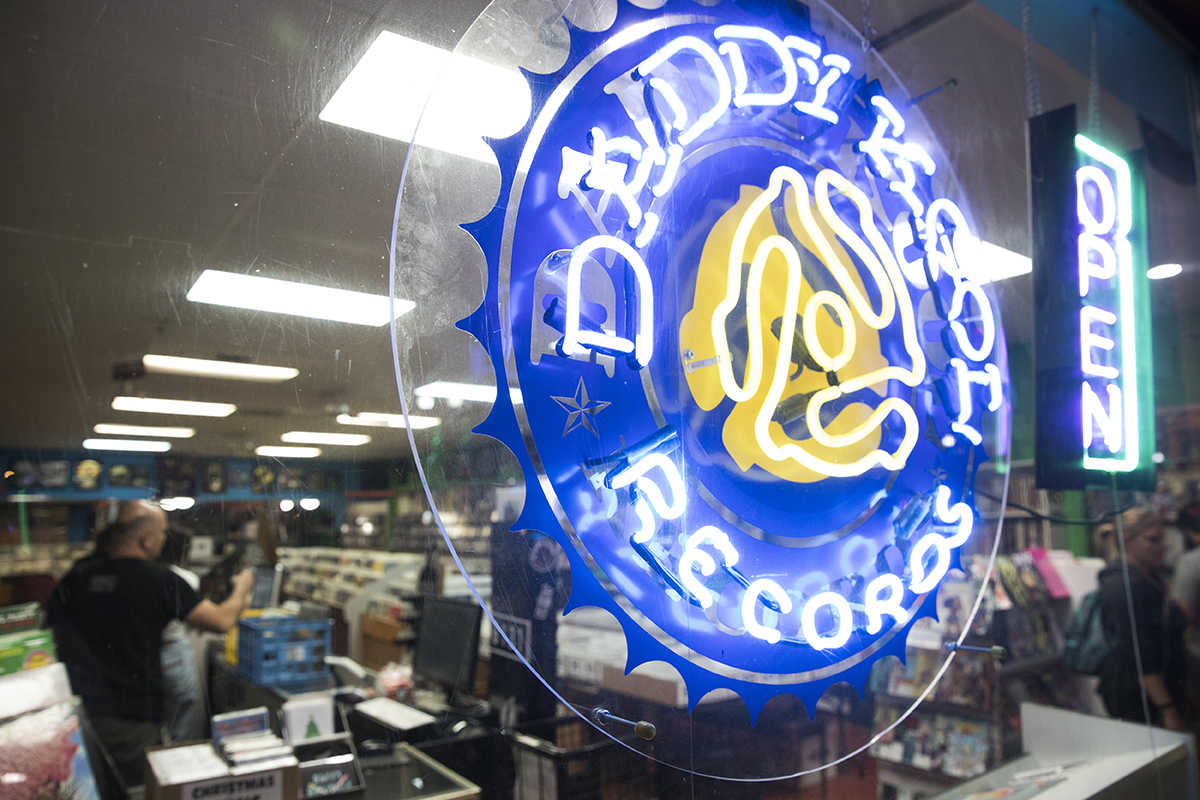How to Get the Most When You Sell Your Vinyl Record Collection

Whether due to a death in the family or a Kondo-inspired purge by your parents, you’re probably like me and have a box of vinyl records in the back of your closet under a blanket of dust.
And though that Frank Sinatra album might inspire memories of standing on your dad’s feet and dancing in the living room, the 50-pound box of records has moved with you twice and a Crosley turntable isn’t on the Christmas list.
It’s time to mine that multi-generational stack of golden oldies for some real gold – or at least some cold cash.
Know What You Have
You should be able to determine very quickly if there is anything in the collection anyone would want to buy.
If you’ve got Beatles, Rolling Stones and other Woodstock-era bands, that’s a good start, according to two music critics/record-store aficionados we spoke with. Proto-punk and early punk bands (The Kinks, The Velvet Underground, Captain Beefheart & His Magical Band), early R&B and soul (James Brown, Ray Charles) and ’50s-era music (Elvis Presley) do well in resale.
For example, bids on eBay for a 1967 mono copy of The Velvet Underground and Nico with the Andy Warhol banana cover topped $400 in October. Rarity, condition and finding the right buyer will put the most money into your pocket.
“But if you’re seeing swing-era, easy-listening or big bands (in your collection),” says former Tampa Tribune music critic Curtis Ross, “you better develop a taste for that music yourself.” He suggests dropping by Goodwill and checking out their bins. If what they are selling is what you’ve got in the closet, you may need to lower your expectations for resale.
And let’s just get this out of the way, now: If you’ve got a rare single of The Sex Pistols’ “God Save the Queen,” you might fetch you enough cash to buy a new car — or at least a used one. In 2012, a 35-year-old, 7-inch acetate of the seminal Sex Pistol’s single sold at auction for $19,672, according to Whatsellsbest.
Other Selling Points
Mono vs. Stereo

Audiophiles are drawn to original mono titles, rather than stereo, and are willing to pay. Mono recordings have all the sound in a single channel, whereas stereo uses several audio channels allowing the listener to hear vocals and musical instruments from various directions.
Beatles fans are most cited in seeking mono titles of the Fab Four’s early albums because that is how they were originally recorded. The stereo mixes came later and according to Beatles expert Bruce Spizer speaking to radio.com, the mono albums represent how the band and producer George Martin “intended it to be heard.”
Original Pressings
Records that have low pressing numbers, usually below 500, are more valuable. On Oct. 1, The Beatles “White Album,” with a pressing number of 441 sold for $2,599.99 on eBay. Numbers and letters engraved in the vinyl close to the record label helps determine when the record was cut. You’ll need to do some research, and Discogs has databases to assist.
Also, at Original Pressings, you can give specifics about your vinyl to a small group of record collectors and music enthusiasts who will help you identify and price your records. There is no set price for this help, but a donation for the service s suggested.
Rarities
One-time albums, singles or re-releases from a popular artist, such as limited Record Day releases, are popular because so few may be available. The “James Brown Revue: Live at the Apollo IV,” released on Record Day 2016 was highly coveted because it had never been issued on vinyl. The range of resale for this is $29 to $99 on eBay.
The upcoming Record Store Day satellite event on Black Friday (Nov. 24) also has collectors and resellers salivating. Among the exclusives and small runs are a double-picture disc of Gorillaz’s “Humanz,” 850 copies of a 7-inch vinyl from Sparks, and the Paul McCartney classic “Wonderful Christmastime” released on red and green vinyl.
Condition, condition, condition

Obviously, the better shape the record and its packaging are in, the more desired it becomes. To keep your vinyl in shape for longtime listening or eventual resale you should practice these simple tips:
1. Keep them vertical — don’t stack your records or lay the vinyl flat, it only causes them to warp;
2. Store them where it is cool and dry — avoid rooms open to extreme temperatures and humidity, such as basements, attics and garages;
3. Keep them in their sleeves — The paper sleeves keep out dirt and dust, limiting damage;
4. Find a proper storage container — whether it’s record crates or cases or shelving, ensure it can handle the weight of your records.
Extras
Records that include liner notes, lyric sheets, posters or photos that were part of the original product are coveted by collectors.
Mint/Near Mint
Older records that have never been opened or played, still sealed in the original plastic, would be deemed in “mint” condition and are few and far between. On Discogs this grade is sparingly, “if ever,” used.
Near mint condition is described as near perfect, with no obvious signs of wear. The record inserts, including posters, lyrics and more, also should be intact.
A Very Good (Plus) grade has been played but might be scuffed or have scratches but can still be played without listening issues. The cover also may show some wear. This vinyl is worth about 50 percent of Near Mint value, according to discogs.com. A Very Good grade brings a 25 percent of Near Mint value.
Demand Versus Price
How many times have you been to a yard sale and watched someone buy a single bookend or a Monopoly game that’s missing all its $1s and $50s? There is a buyer for just about anything, even “Playing with Fire” by Kevin Federline.
You can determine the demand for what you’ve got and its resale value at Discogs, an online database and marketplace for records and CDs. Practically every artist has a page with a complete discography, tracklist, information on reissues and other fun facts.
The site’s value to you is it allows you to see if the market is flooded with albums from your collection, how much dealers are selling the records for and how much buyers are willing to pay.
“Albums from your grandparents’ collection, including Sinatra, Streisand and The Platters, has a target audience that could be tough to find at a record store,” says Gabe Echazabal, a former longtime manager at Vinyl Fever in Tampa.
Where to Make the Sale

Streaming and digital downloads rule, but nostalgia is keeping a tight hold on vinyl sales. Vinyl record sales increased for the 11th consecutive year in 2015, according to Nielsen Music and are expected to end 2017 with sales of 40 million units, reports Forbes magazine.
Teens and millennials are buying new vinyl from current bands and vintage vinyl from their parent’s era. “Duran Duran has a whole new audience, because millennials remember hearing the ’80s music from their parents,” says Echazabal.
He also says many people are trying to rebuild a collection they’d sold years ago. “They come back and try to rebuy what they sold to us, and they’d have to pay more,” he says.

When it comes to selling your collection, record-store owners and managers will likely buy your vinyl for about half of what they think they can sell it for.
When sorting through a collection, Echazabal says there would be 50-cent piles, $1 piles, $2 piles and $5 piles. “And most of what we would fill our 99-cent bins with, we’d pay anywhere from a quarter to 50 cents for,” he says. “This would consist of really common titles (such as Billy Joel’s “52nd Street).”
When an artist dies, such as Tom Petty, David Bowie, Michael Jackson and Prince, there is an expected spike in demand for that artist’s work, but it doesn’t necessarily translate to a spike in price. That’s because when a musician dies, there also is a flood of that artist’s music available, and that keeps the price down.
Other places to sell records:
- Flea markets
- eBay
- Cdandlp.com
- Used bookstores
- Discogs.com
Ultimately, selling and buying records is all about personal likes and dislikes. One person’s script-cover “Born to Run” by Bruce Springsteen is another person’s Frisbee.
Kim MacCormack is the former entertainment editor at The Tampa Tribune. She decided not to sell her precious “Portrait of Donny (Osmond)” album.
















